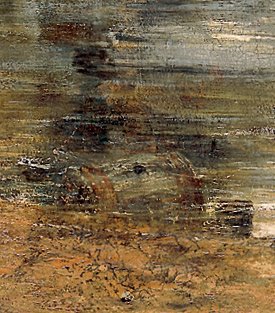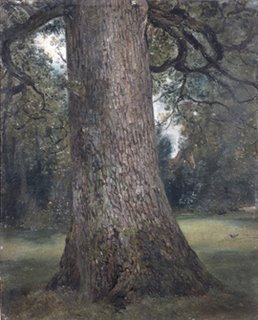Charles T. Downey, Constable in London (November 23, 2003) Mark Barry, A Parade of Clouds (August 10, 2004) Charles T. Downey, Eric Ravilious (August 4, 2005) Mark Barry, In Appreciation of Clouds (June 14, 2006) John Gage, Sarah Cove, et al., Constable: The Great Landscapes |
The main draw of this exhibition is the opportunity to see all of the large landscapes that Constable painted for academic consideration, all of which have become his most iconic works. Not only can you stand in front of The Haywain and Stratford Mill (actually released by the National Gallery in London), The White Horse (The Frick Collection), The Leaping Horse (Royal Academy of Arts), Chain Pier, Brighton and The Opening of Waterloo Bridge (Tate Britain), View on the Stour near Dedham (Huntington Library), and Salisbury Cathedral from the Meadows (Private collection), you can also compare each finished painting in almost all cases with a full-size oil sketch (hung side by side) and often other studies, almost all from different museums. This is the first opportunity to see all of these works together in one building since Constable died.
 The wall text puts each work into the context of Constable's life and the geographical setting of the Stour valley. At one point, a map shows the world of the painter's youth, the course of the Stour River, the location of the Flatford and Dedham mills and locks (both owned by Constable, Sr.), and the other locales from Suffolk that appear again and again in Constable's landscapes. Judging by some photographs of what the area looks like today, not much has changed in this rural setting only an hour from London, probably the result of zealously preservation. Flatford Mill is now a Field Studies Council Centre, where adults and children can take classes on various subjects, and you can even stay the night.
The wall text puts each work into the context of Constable's life and the geographical setting of the Stour valley. At one point, a map shows the world of the painter's youth, the course of the Stour River, the location of the Flatford and Dedham mills and locks (both owned by Constable, Sr.), and the other locales from Suffolk that appear again and again in Constable's landscapes. Judging by some photographs of what the area looks like today, not much has changed in this rural setting only an hour from London, probably the result of zealously preservation. Flatford Mill is now a Field Studies Council Centre, where adults and children can take classes on various subjects, and you can even stay the night.The exhibit also gives insight into how Constable worked, both en plein air and in the studio, guiding your eye to pick out the changes in details from sketch to finished painting. Do not miss the chance to hear the explanation for that troublesome shadow in the middle foreground of The Haywain. If there is one painting you think you know, it is this one, but there in the center of the full-size oil sketch is a figure on a horse standing on the near bank. In the finished painting, Constable began by retaining that figure, then replacing it with a barrel, and finally removing that, too. When you know they used to be there, both of those things pop spectrally out of the painting, defying Constable's ingenious attempts to disguise them as shadows from the tree across the bank on land and water. I will never see the painting the same way again.
 The appreciation of Constable's technique and process is not exactly what was proposed by Washington's newspaper critics. Blake Gopnik's dutiful bowing and scraping before the avatars of political correctness is lamentable, in his review in the Post, ascribing Constable's interest in painting idealized landscapes of the countryside to making "ideas of social change or reform [seem] repugnant and dangerous." Even so, that is at least more interesting than Joanna Shaw-Eagle's gross assumption that Constable is "an often boring, stodgy painter" of "academic, bucolic landscapes" in her review in the Times.
The appreciation of Constable's technique and process is not exactly what was proposed by Washington's newspaper critics. Blake Gopnik's dutiful bowing and scraping before the avatars of political correctness is lamentable, in his review in the Post, ascribing Constable's interest in painting idealized landscapes of the countryside to making "ideas of social change or reform [seem] repugnant and dangerous." Even so, that is at least more interesting than Joanna Shaw-Eagle's gross assumption that Constable is "an often boring, stodgy painter" of "academic, bucolic landscapes" in her review in the Times. Constable's influence on later painters, particularly the Barbizon school in France and their descendents, the Impressionists, was due to the showing of some of his canvases throughout the 19th century. When you see the paintings in person, you can appreciate his technique in a much more direct and profound way. His application of white and golden highlights to show the dappling of light, sometimes called the "Constable snow effect," was imitated by many later painters. The glowing hues of his ever-shifting clouds, which I found myself going over inch by inch in many of the large paintings, were based on acute and regular meterological observation of the skies outdoors.
Constable's influence on later painters, particularly the Barbizon school in France and their descendents, the Impressionists, was due to the showing of some of his canvases throughout the 19th century. When you see the paintings in person, you can appreciate his technique in a much more direct and profound way. His application of white and golden highlights to show the dappling of light, sometimes called the "Constable snow effect," was imitated by many later painters. The glowing hues of his ever-shifting clouds, which I found myself going over inch by inch in many of the large paintings, were based on acute and regular meterological observation of the skies outdoors.In some cases, modern painters and museum-goers have been more impressed by Constable's sketches, which have been shown occasionally over the years as finished works. When you see this exhibit, you realize that nothing could be farther from the truth, that even some canvases long considered final versions are probably only the last sketch, left uncompleted by the painter's inability to finish the work to meet the standards of the Royal Academy, whose approval he so desperately craved. Unlike those who followed him, he was unwilling to stop at a point in the artistic process where he had only made a basic sketch of what his eye saw in the field. As much as I would like to think of paintings like this gorgeous black stormcloud over the ocean or the cloud studies as finished works, that would be anachronistic. Go see for yourself.
Constable's Great Landscapes: The Six-Foot Paintings will be on view in the National Gallery of Art's East Building through December 31.
This show is great for having the oppotunity to see his working techniques. After seeing Constable's Clouds in New York two years ago, I kept focusing on the sky. The lectures on Sunday were excellent, too. It's worth checking the schedule with a show that you like. The experts who curated the show have a lot of information to share for FREE!
ReplyDeleteCharles, you get all the good assignments! There is something about the drawings and watercolors that I relate to most in a contemporary sense. While the paintings are a tour de force and brilliant, his watercolors, such simple spare gestures; he nails it! Simply amazing.
ReplyDeleteI think this may be an issue of familiarity. We're so used to seeing the finished paintings and not as often the drawings. The van Gogh exhibit at the Met last season was a similar experience. The drawing were far more exciting than the paintings.